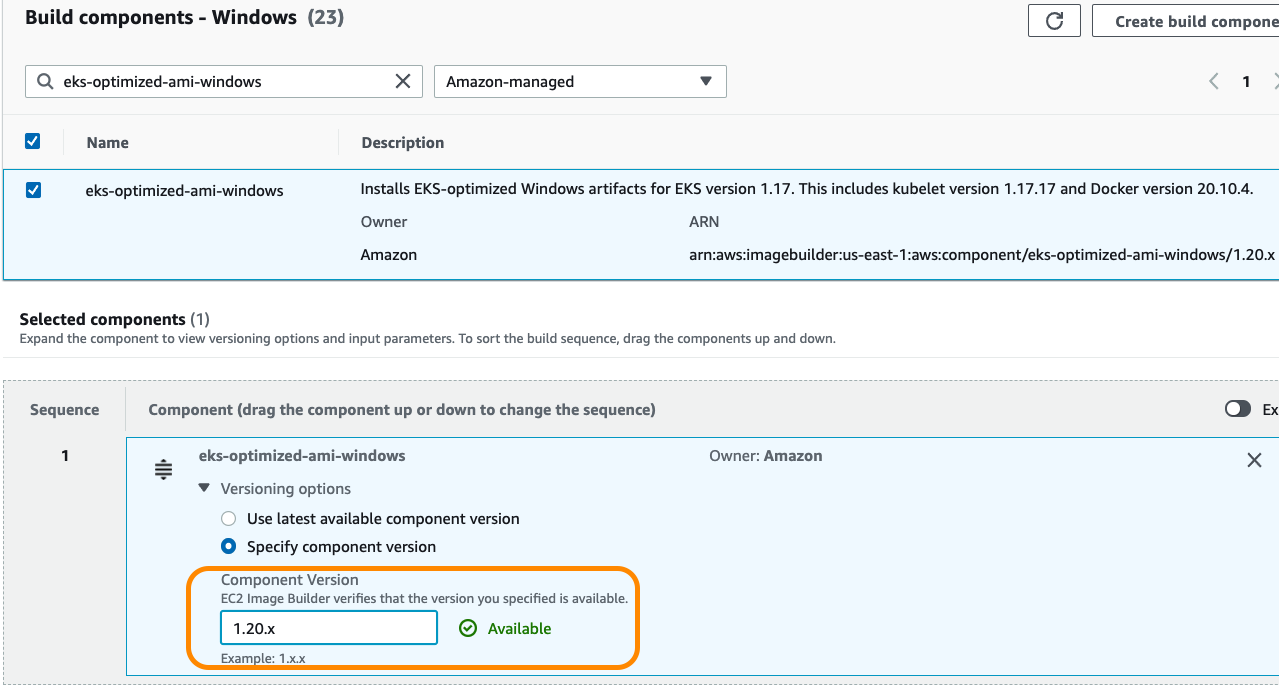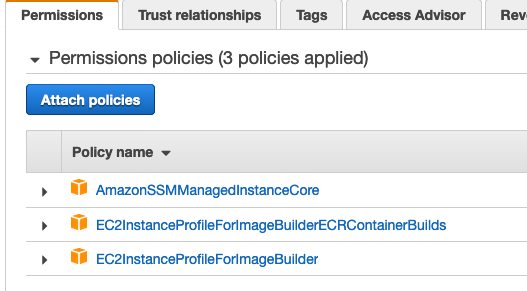We've Moved to the AWS Docs! 🚀
This content has been updated and relocated to improve your experience. Please visit our new site for the latest version: AWS EKS Best Practices Guide on the AWS Docs
Bookmarks and links will continue to work, but we recommend updating them for faster access in the future.
Amazon EKS optimized Windows AMI management¶
Windows Amazon EKS optimized AMIs are built on top of Windows Server 2019 and Windows Server 2022. They are configured to serve as the base image for Amazon EKS nodes. By default, the AMIs include the following components: - kubelet - kube-proxy - AWS IAM Authenticator for Kubernetes - csi-proxy - containerd
You can programmatically retrieve the Amazon Machine Image (AMI) ID for Amazon EKS optimized AMIs by querying the AWS Systems Manager Parameter Store API. This parameter eliminates the need for you to manually look up Amazon EKS optimized AMI IDs. For more information about the Systems Manager Parameter Store API, see GetParameter. Your user account must have the ssm:GetParameter IAM permission to retrieve the Amazon EKS optimized AMI metadata.
The following example retrieves the AMI ID for the latest Amazon EKS optimized AMI for Windows Server 2019 LTSC Core. The version number listed in the AMI name relates to the corresponding Kubernetes build it is prepared for.
aws ssm get-parameter --name /aws/service/ami-windows-latest/Windows_Server-2019-English-Core-EKS_Optimized-1.21/image_id --region us-east-1 --query "Parameter.Value" --output text
Example output:
Managing your own Amazon EKS optimized Windows AMI¶
An essential step towards production environments is maintaining the same Amazon EKS optimized Windows AMI and kubelet version across the Amazon EKS cluster.
Using the same version across the Amazon EKS cluster reduces the time during troubleshooting and increases cluster consistency. Amazon EC2 Image Builder helps create and maintain custom Amazon EKS optimized Windows AMIs to be used across an Amazon EKS cluster.
Use Amazon EC2 Image Builder to select between Windows Server versions, AWS Windows Server AMI release dates, and/or OS build version. The build components step, allows you to select between existing EKS Optimized Windows Artifacts as well as the kubelet versions. For more information: https://docs.aws.amazon.com/eks/latest/userguide/eks-custom-ami-windows.html

NOTE: Prior to selecting a base image, consult the Windows Server Version and License section for important details pertaining to release channel updates.
Configuring faster launching for custom EKS optimized AMIs¶
When using a custom Windows Amazon EKS optimized AMI, Windows worker nodes can be launched up to 65% faster by enabling the Fast Launch feature. This feature maintains a set of pre-provisioned snapshots which have the Sysprep specialize, Windows Out of Box Experience (OOBE) steps and required reboots already completed. These snapshots are then used on subsequent launches, reducing the time to scale-out or replace nodes. Fast Launch can be only enabled for AMIs you own through the EC2 console or in the AWS CLI and the number of snapshots maintained is configurable.
NOTE: Fast Launch is not compatible with the default Amazon-provided EKS optimized AMI, create a custom AMI as above before attempting to enable it.
For more information: AWS Windows AMIs - Configure your AMI for faster launching
Caching Windows base layers on custom AMIs¶
Windows container images are larger than their Linux counterparts. If you are running any containerized .NET Framework-based application, the average image size is around 8.24GB. During pod scheduling, the container image must be fully pulled and extracted in the disk before the pod reaches Running status.
During this process, the container runtime (containerd) pulls and extracts the entire container image in the disk. The pull operation is a parallel process, meaning the container runtime pulls the container image layers in parallel. In contrast, the extraction operation occurs in a sequential process, and it is I/O intensive. Due to that, the container image can take more than 8 minutes to be fully extracted and ready to be used by the container runtime (containerd), and as a result, the pod startup time can take several minutes.
As mentioned in the Patching Windows Server and Container topic, there is an option to build a custom AMI with EKS. During the AMI preparation, you can add an additional EC2 Image builder component to pull all the necessary Windows container images locally and then generate the AMI. This strategy will drastically reduce the time a pod reaches the status Running.
On Amazon EC2 Image Builder, create a component to download the necessary images and attach it to the Image recipe. The following example pulls a specific image from a ECR repository.
name: ContainerdPull
description: This component pulls the necessary containers images for a cache strategy.
schemaVersion: 1.0
phases:
- name: build
steps:
- name: containerdpull
action: ExecutePowerShell
inputs:
commands:
- Set-ExecutionPolicy Unrestricted -Force
- (Get-ECRLoginCommand).Password | docker login --username AWS --password-stdin 111000111000.dkr.ecr.us-east-1.amazonaws.com
- ctr image pull mcr.microsoft.com/dotnet/framework/aspnet:latest
- ctr image pull 111000111000.dkr.ecr.us-east-1.amazonaws.com/myappcontainerimage:latest
To make sure the following component works as expected, check if the IAM role used by EC2 Image builder (EC2InstanceProfileForImageBuilder) has the attached policies:

Blog post¶
In the following blog post, you will find a step by step on how to implement caching strategy for custom Amazon EKS Windows AMIs:
Speeding up Windows container launch times with EC2 Image builder and image cache strategy